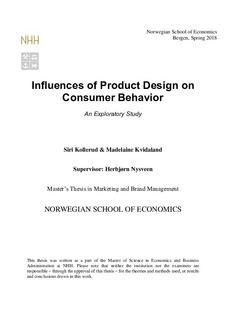Influences of product design on consumer behavior : an exploratory study
Master thesis
Permanent lenke
http://hdl.handle.net/11250/2560953Utgivelsesdato
2018Metadata
Vis full innførselSamlinger
- Master Thesis [4372]
Sammendrag
In recent years the world has been witnessing a tremendous change in the sportswear industry
when it comes to product design. In the sportswear market today, product design is considered
an important strategic tool for creating product differentiation and customer value. It is no
longer enough for a sportswear brand to be either fashionable or functional, it needs to be
both! Superior design draws customer’s attention and makes the products stand out from
others. Thus, organizations should use resources on designers due to how they believe that
good design improves financial performance. A highly competitive market calls for products
that offers designs with both functional, aesthetic and symbolic value that offers contextually
congruent design and fits with the preferences and tastes of the consumer.
However, there exists limited empirical research on product design and design issues.
This thesis aims to provide a better understanding of how and what managers should think of
when producing and promoting sportswear to consumers. The model in this thesis draws from
established frameworks in the product design literature, where the core of the model is based
on the product design scale of Homburg et al. (2015). The model further adds relevant
extension based on findings in existing product design literature of contextually congruent
design and centrality of visual product aesthetics.
The conceptual model is tested based on an online questionnaire (N=225). The results reveal
that consumers mainly form purchase intentions and word of mouth communication of
sportswear based on brand attitude. Moreover, the social context plays a major role in shaping
purchase intentions. Furthermore, only the aesthetic dimension of product design has a
significant influence on brand attitude. In addition, it shows a positive influence on the
functional dimension of product design. Overall, the constructs investigated in this thesis
explain a high degree of the variance in purchase intention (66,4%) and word of mouth
(37,7%). The thesis concludes with theoretical and managerial implications in addition to
suggestions for future research.
